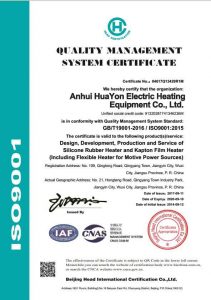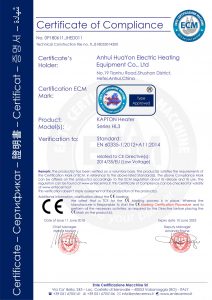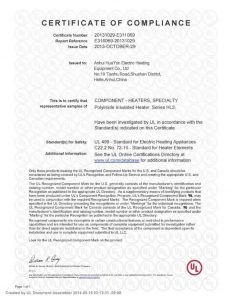250 silicone heating pad×250 mm Quick Detail
Applicable Industries: medicine and healthcare, aerospace and aviation, Automotive industry, Consumer electronics
state: New
Type: electric heater
Birthplace:Anhui, China
brand name: HuaYon customize it
Dimension (L*W*H): personalized
Voltage: 3,7 ~ 480 V
1 one year warranty
Working temperature range: -30~200ºC
Material: Silicone rubber + engraved metal sheet
Thickness: 1,5-3 mm
Back adhesive: 3M 467/468 the personalized
Power density: 0,01-2,5 w/cm²
Power deviation: ±5%
Supply capacity: 50000 units per month
Packaging Details: inner PE bag + card
Certificates: THIS, RoHS, ISO9001
Silicone rubber heater is a type of thin film that heats up when electrified, in a standard thickness of 1.5 mm, Adopting nickel-chromium wires or nickel-chromium foils from 0.05 mm ~ 0.10 mm thick engraved in certain shapes, the heating component is wrapped with heat conductors and insulating materials on both sides, and completed in high temperature die forming and aging heat treatment.
Voltage | 3V-480V | Thickness | 1.5mm-3mm |
Power Density | 0.1-1.2W/CM2 | Insulation Ohm | More than 5MΩ |
Min Size | 10*10mm | Max Temperature | 250 degree |
Max Size | 2000*10000mm | Wire Tension | 15N*15N |
What is silicone rubber heater?
Freeze protection and condensation prevention for many types of instrumentation and equipment.
Medical equipment such as blood analyzers and test tube warmers.
Computer peripherals such as laser printers.
Curing of plastic laminates.
Photo Processing Equipment.
Semiconductor Processing Equipment.
Thermal transfer equipment
Drums and other containers and viscosity control and asphalt storage.
Key features and benefits of silicone rubber heaters include:
Flexibility: The flexibility of silicone rubber allows for molding, bend or mold these heaters to fit various shapes and surfaces. This feature makes them suitable for applications where rigid heaters are not practical..
Uniform heating: These heaters distribute heat evenly across their entire surface., mitigating the appearance of hot spots or cold regions and ensuring constant heating.
Quick response to heating: Silicone rubber heaters are known for their fast response times in reaching and adjusting temperatures., making them suitable for applications requiring rapid heating adjustments.
Durability: silicone rubber is resistant to various environmental factors, like humidity, chemicals and moderate physical wear, which improves the robustness of the heater.
Electrical isolation: The electrical insulating properties of silicone rubber ensure safe use in applications where electrical insulation is vital.
Customizable layout: Manufacturers can customize silicone rubber heaters in terms of size, form, power and temperature distribution to meet specific heating requirements.
Silicone rubber heaters are used in a wide spectrum of industries and applications, including:
Industrial processes: Heat tanks, pipelines, valves and manufacturing equipment, and assist in curing operations, drying and preheating.
Medical devices: They are used in medical equipment as IV bag warmers, heated patient warmers and medical imaging tables.
Aerospace and aviation: preventing ice buildup on aircraft components by deicing critical areas such as wings.
Food and beverage industry: maintenance of specific temperatures in food processing equipment, such as boilers and tanks, during production processes.
electronics: Integration in electronic cabinets, display panels and other devices for temperature regulation.
Automotive section: Used in seat heating applications, defrosting windows and preheating engines in vehicles.
A 250° silicone heating pad×250 mm is an electric heating element made of a flexible silicone rubber material that measures 250 millimeters per 250 mm (about 9,84 inches by 9,84 inches). These heating pads are designed to provide constant and even heating over its surface.
Features and uses
Characteristics:
Flexible and thin: Silicone rubber construction allows the heating pad to be flexible and conform to the shape of the surface it is applied to.
Even heat distribution: the heating element, usually made of resistance wire or etched sheet, provides even heat distribution.
Durable and robust: silicone rubber is moisture resistant, chemicals and other environmental factors, making the heating pad suitable for various applications.
Customizable: These heating pads can often be customized in terms of voltage, power and shape to suit specific requirements.
Usos:
3d printers: commonly used as a hot bed to ensure proper adhesion of the printed object and avoid deformations.
Industrial equipment: They are used to provide constant heating in processes that require precise temperature control.
Medical devices: They are used in applications where flexible and constant heating is needed, as in patient warming devices.
automotive: Used to defrost, defrost and regulate temperature in various auto parts.
Consumer electronics: Used in devices that require heat to be maintained for functionality or comfort.
Specifications
Typical specifications for a 250 degree silicone heating pad×250 mm may include:
Voltage: commonly available in various voltages, as 12 V, 24 V o 110 V, depending on the application.
Power: Rated power may vary, often oscillating between 100 W y 500 W or more, according to heating requirements.
Temperature range: typically capable of operating within a wide temperature range, often of -60 °C a 230 °C (-76 °F a 446 °F).
Adhesive backing: Some pads come with adhesive backing for easy installation on various surfaces.
Installation and use
Mounting: The heating pad can be mounted using an adhesive backing, mechanical fasteners or fastening methods.
Control: Often combined with a temperature controller or thermostat to regulate and maintain the desired temperature.
Security: Includes overheat protection features to prevent overheating and ensure safe operation.
Advantage
Energy efficiency: Provides efficient heating with minimal energy loss.
Versatile: Suitable for a wide range of applications due to its flexibility and customizable nature.
Reliable: Offers consistent performance and long life thanks to robust silicone material.
In summary, a 250 degree silicone heating pad×250 mm is a versatile and reliable heating solution for various industrial applications, medical, automotive and consumer, providing efficient, uniform heating with the benefits of flexibility and durability.
![]()
![]()





Reviews
There are no reviews yet.